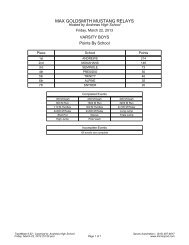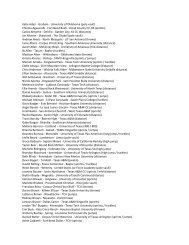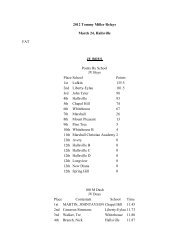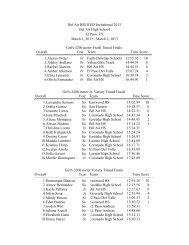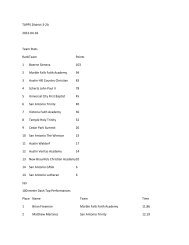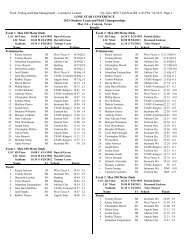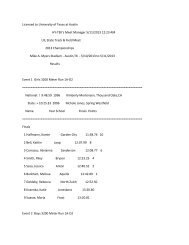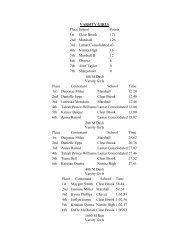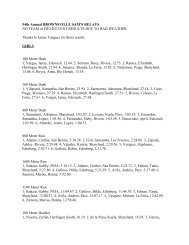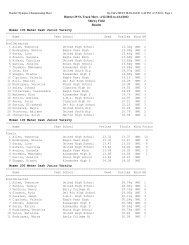1. PAGES 1-35 - Texas Track & Field Coaches Association
1. PAGES 1-35 - Texas Track & Field Coaches Association
1. PAGES 1-35 - Texas Track & Field Coaches Association
You also want an ePaper? Increase the reach of your titles
YUMPU automatically turns print PDFs into web optimized ePapers that Google loves.
MENTAL IMAGERY<br />
Additionally, more than half of the participants improved by a z-<br />
score of 0.55 or greater, with three athletes having improved by a<br />
z-score above <strong>1.</strong>0. Despite the small number of participants, the<br />
improvements still resulted in a marginally significant 0.057 p-<br />
value. These quantitative results were mirrored by the responses<br />
of the athletes to the qualitative reflective prompt.<br />
QUALITATIVE RESULTS<br />
The qualitative results stemmed from participant responses<br />
to the reflective prompt. Athletes were asked if they believed<br />
imagery had an effect on confidence and whether they intended<br />
to continue imagery in the future. Athlete responses to the<br />
two parts of the prompt were analyzed separately by searching<br />
for common themes and subthemes.<br />
All athletes responded that they felt imagery had a positive<br />
influence on their levels of confidence. Athlete responses to<br />
why or how imagery affected confidence were grouped into<br />
physically- and psychologically-based reasons (See Table 2 for<br />
the complete analysis of why participants believed imagery<br />
enhanced their confidence). All seven participants noted at<br />
least one psychological explanation for why they believed<br />
imagery positively influenced confidence compared to only<br />
four who believed their confidence was physically based.<br />
In addition to the unanimous agreement that imagery had<br />
an influence on sport confidence, all athletes responded that<br />
they planned to continue using imagery in the future. Again,<br />
reasons were grouped into the categories of physically and psychologically<br />
based as well as a generic category for unspecified<br />
responses or those that did not fit into either of the main categories<br />
(see Table 3, pg 42 for the complete analysis of why participants<br />
planned to continue imagery use). Again, athletes<br />
overwhelmingly stated that they intended to continue their use<br />
of imagery for psychological reasons over the relaxing physiological<br />
response.<br />
TRIANGULATION OF RESULTS<br />
Following the separate analysis of the quantitative TSCI<br />
results and the qualitative responses to the reflective prompt,<br />
the two sets were compared. The qualitative responses that<br />
athletes experienced positive influences on their self-confidence<br />
from the imagery were supported by the fact that TSCI<br />
scores increased by a significant margin during the six-week<br />
imagery program. In addition, the unanimous response that all<br />
athletes intended to continue their use of imagery following the<br />
conclusion of the intervention period indicated that the exercises<br />
were working and enjoyable to the participants.<br />
The concurrence of the quantitative and qualitative results in<br />
this study was no surprise, as previous research made similar<br />
findings. In a qualitative study, Hays et al. (2007) found that a<br />
majority of athletes found mental preparation, including<br />
imagery exercises, to be a source of confidence. In an implementation<br />
of a mental training program, which included extensive<br />
use of imagery, during the competitive season, Thomas et<br />
al. (2007) found this mental training had a significant effect on<br />
both the athletes’ frequency and intensity of self-confidence.<br />
In studies focusing solely on imagery, similar to this one, Short<br />
and Short (2005) and Cumming et al. (2007) found that imagery<br />
was consistently correlated with high scores in self-confidence.<br />
Despite the small number of participants in this study, the<br />
results were supported by the findings of past qualitative and<br />
quantitative research, which further validated the findings of<br />
this study.<br />
DISCUSSION<br />
Of seven participants who completed the six-week mental<br />
imagery program, six achieved higher sport confidence scores<br />
on the TSCI following the intervention (M=98.3 compared to<br />
M=89.3). Additionally, five of the seven scored at least one-half<br />
of a standard deviation higher (SD=10.2) on the post-intervention<br />
TSCI than they had prior to the imagery program. The only<br />
athlete that did not experience an increase in sport confidence<br />
scores saw a decrease of only one point. The results were only<br />
marginally significant (p=0.057), possibly due to the small number<br />
of participants involved in the study, but still suggested that<br />
the consistent use of MG-M imagery by athletes could increase<br />
their sport confidence overall.<br />
40 techniques AUGUST 2011



